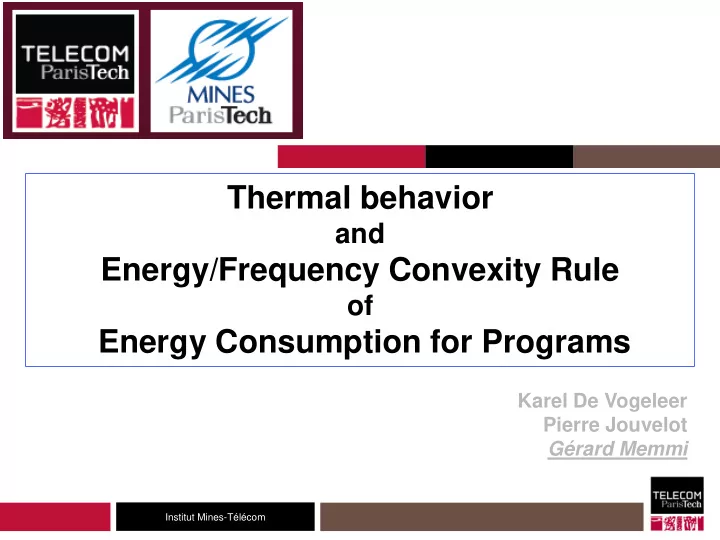

Thermal behavior and Energy/Frequency Convexity Rule of Energy Consumption for Programs Karel De Vogeleer Pierre Jouvelot Gérard Memmi Institut Mines-Télécom
Motivations for focussing on mobile computing It is NOT the energy saving per se : • A smartphone CPU consumes between 60 to 400mW • There are about 7x10 9 smartphones sold in the last 5 years, there will be 50x10 9 ‘smart objects ’ in 2020 • A saving of 30% would provide grossly about 280 MW for the smartphones, about 3 GW for the smart objects • This would only save between a tidal and a nuclear power station Focussing on mobile sytems: they are ‘ energy-critical ’ : it is being constantly looking for providing more autonomy with a QoS unchanged It is about a natural-resource-free energy saving Modèle de présentation Télécom ParisTech 2 25/05/2016 Institut Mines-Télécom
Thermal Behavior: Power-temperature rule Passive Cooling rule Modèle de présentation Télécom ParisTech 3 25/05/2016 Institut Mines-Télécom
Temperature impacts energy consumption Institut Mines-Télécom
Passive Cooling Rule Modèle de présentation Télécom ParisTech 5 25/05/2016 Institut Mines-Télécom
Approximative solutions 6 25/05/2016 Institut Mines-Télécom Modèle de présentation Télécom ParisTech
Isothermal assumption Institut Mines-Télécom
Contribution on thermal behavior Necessary for reproducible measurement and for accurate energy consumption models Power – temperature relationship Approxiations for practical use 8 25/05/2016 Institut Mines-Télécom Modèle de présentation Télécom ParisTech
EFCR: the energy – frequency convexity rule Modèle de présentation Télécom ParisTech 9 25/05/2016 Institut Mines-Télécom
Fragmenting energy consumption per system module Institut Mines-Télécom
Power and time model Institut Mines-Télécom
Optimal frequency and Convexity (EFCR) Institut Mines-Télécom
3 classes of processors There exists a domain of frequencies where the processor is delivered by the manufacturer: f k must be smaller than f since f k a fraction of f Save for overclocking or underclocking Institut Mines-Télécom
State of the art Convexity was already observable, however no analytical studies were performed Fan, X., Ellis, C. S., and Lebeck, A. R. The synergy between power-aware memory systems and processor voltage scaling. In PACS’04 Le Sueur, E., and Heiser, G. Dynamic voltage and frequency scaling: the laws of diminishing returns. In PACS’10 Institut Mines-Télécom
Testbed Institut Mines-Télécom
Experimental validation In color, the measurements In doted lines the theoretical EFCR calculation When N increases, f opt stays stable 16 25/05/2016 Institut Mines-Télécom Modèle de présentation Télécom ParisTech
Conclusion Modèle de présentation Télécom ParisTech 17 25/05/2016 Institut Mines-Télécom
Towards energy program profiling • Created by tuning clk frequency and performing standard program transformation 18 Institut Mines-Télécom Département Informatique et Réseaux
Energy-Oriented Environment First measurement and results are very encouraging, setting expectations in the 10-40% saving range rather than in the 2-5% initially anticipated saving range Exploiting energy-frequency convexity Eliminating temperature impact in our models Wider array of experimentation, more accurate measurement and mathematical models, wider temperature range More research on energy program profiling • Handling various architectures (eg cache) • Understanding how and when to play with clock frequency changes • Temperature on line monitoring Towards an energy-oriented compiler middle-end, and operating system technology 19 Institut Mines-Télécom Département Informatique et Réseaux
Bibliography 20 25/05/2016 Institut Mines-Télécom
Thank you 21 25/05/2016 Institut Mines-Télécom
Recommend
More recommend